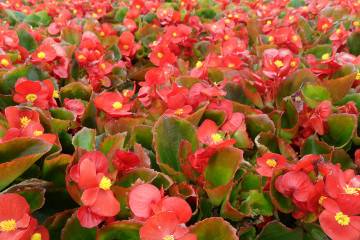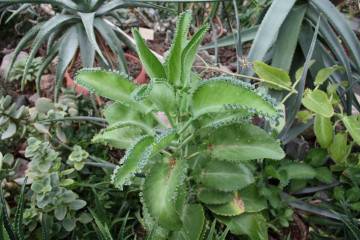Soil for violets - we make the best composition ourselves
Content:
When choosing a soil for violets, it is necessary to take into account the conditions in which they grow in their natural environment. Some Saintpaulias feel great on the mountainside, where there is practically no humus. Others prefer sun-drenched meadows or prairies. In temperate latitudes, violets grow on forest edges with soft, loose soil. For their saintpaulias, flower growers at home independently prepare soil or purchase ready-made ones in stores.
What soil do violets like?
Saintpaulias are moisture-loving, but the roots of the flower rot from stagnant water. The plant needs loose soil for violets - a light soil that does not turn into a lump when watering. The plant needs trace elements, nutrients and slightly acidic soil to grow. On a neutral plant, it feels depressed, on alkaline ones with a pH of less than 4.5, it dies.
Essential ingredients and minerals
The mixture contains soil-forming components, for which the roots hold the plant in an upright position. Nutrient substrate with a set of minerals involved in photosynthesis. These are mineral macro- and microelements.
What are all soil elements for?
Of organic and inorganic compounds in a soil mixture for violets and saintpaulias, the following must be present:
- nitrogenous components (nitrogen fertilizers);
- potassium salts (potassium chloride or sulphate);
- phosphorus substances (superphosphate or other fertilizers with phosphorus).
In addition, in small doses, boron, zinc, copper, magnesium and other elements of the periodic table are required. All of them are needed for the full development of plants.
Soil acidity
The recommended acidity level is between 5.5 pH and 6.5. The plant absorbs nutrients poorly if electrolyte balance is not created. The acidity after the test is regulated by indicator strips. Stir 2 tbsp in a glass of water. l. land. Dip a test strip into the solution. By the change in color, the acidity of the soil is judged. The pH is lowered by adding dolomite flour. Increase - with sour water or low-lying peat.
What land is needed for violets
In special formulations, the concentration of nutrients is balanced for the species Saintpaulias. Some varieties of breeding flowers prefer a special soil, it is selected experimentally. Chimeras prefer a land rich in humus.
More fillers are added to the soil for small-leaved Saintpaulias. It has been noticed that pink violets are the most unpretentious to the soil, capable of growing on humus. Purple ones are capricious, their abundance of flowering depends on the presence of phosphorus.
What soils exist
So, what kind of soil is needed for indoor violets? It can be a ready-made universal primer for indoor flowers or horticultural crops. The main thing is to check the correspondence of the acidity of the soil mixture. The condition of the plant depends on this.It is not a fact that in such a land there are nutrients necessary for violets in full. Better not to risk it.
Ready-made professional primers
Land mixtures are similar in composition, they contain:
- high-moor (rotted) and low-lying (acidic) peat;
- some kind of baking powder;
- complex of mineral supplements.
The exception is coconut substrate. Such soil for Saintpaulias is called "coconut peat". It is sold in briquettes, bars, large tablets. Contains essential nutrients, sterile. There are no bacteria or insects in the mixture of coconut fibers, nut flakes, peel residues. Coconut ingredients have good water retention capacity.
What kind of soil is better for violets is incorrect to say. Each grower chooses the composition he likes. Features of the composition of mixtures:
- "Violet" brand GreenUP is universal, in addition to peat, dolomite flour, it contains phosphorus, rare trace elements.
- The Garden of Miracles for Saintpaulias contains river sand, vermicompost, agroperlite. It is purchased by nurseries engaged in breeding work.
- Greenworld universal flower primer contains perlite, soil pH varies within the desired range.
However, the ideal soil for violets is "Aurica's Gardens", packaged in 1 liter. The package is laid in layers:
- turf land
- peat containing up to 5% humus;
- river sand, which improves drainage;
- sphagnum moss, which has bactericidal properties;
- vermiculite crumb, which forms the texture of the soil;
- birch or aspen charcoal is a good antiseptic;
- trace elements for indoor flowers.
The main task of the soil mixture is to form an earthen coma that does not require loosening. Light soil is easy to reach when replanting, it is suitable for wick irrigation.
Average prices
To compare the cost of the finished soil, packages of the same capacity, 5 l each, were selected:
- The most expensive potting mix is coconut; packaging costs around 350 rubles *;
- Universal primer for flowers Greenworld - 200 rubles;
- Soil "Violet Saintpaulia" based on peat - 185 rubles;
- Classman TS-1 - 150 rubles;
- "Flower happiness" - from 90 rubles.
Approximate prices are indicated, actual prices depend on the volume of the purchase, the region (transport costs vary), the size of the store's trade margin. You can buy a package of domestic mixture within 50 rubles.
How to prepare the soil yourself
Some growers prefer to make their own planting mixture. In the ground for violets, if a mixture is prepared with your own hands, other components are added. This is garden or forest land, compost.
Nutrient components
The basis of the nutrient substrate is:
- leafy earth - rotted leaves mixed with rocks of rocky deposits of the earth's crust;
- sod land - part of the fertile layer, penetrated by the roots of perennial grasses;
- biohumus - a concentrate of plant residues processed by worms;
- compost.
Nutrient soil is collected in areas located far from technogenic zones.
Excipients
The fillers are usually peat, plant fibers rotted without air access. Low-lying peat for violets regulates acidity. Replacement - coniferous soil - a layer of rotted needles mixed with the ground.
Baking powder
Loosening components provide the necessary water flow to the drainage layer, soil air permeability. For loosening, use perlite, vermiculite, river sand, foam balls. White balls - baking powder that are part of ready-made mixtures.Without them, the earth will crumple up and dry out quickly.
Moisture retainers
High-moor peat, compost and leaf soil absorbs moisture well. Layered vermiculite is also able to retain liquid in the soil, preventing it from immediately evaporating. But sphagnum moss keeps moisture best of all.
Proper sterilization of the earth
There are chemical and thermal methods for soil disinfection. The first is treatment with 1% potassium permanganate solution. The second is heating the earth in the oven or microwave for half an hour.
Component ratio
Popular recipes for soil for violets, do-it-yourself composition is made from substrates available at home. What the earth can consist of:
- Peat, universal ready-made soil, perlite, sphagnum moss are mixed in a ratio of 2: 1: 1: 1. Add ground charcoal at the rate of 1 tbsp. l. on a sheet of the finished mixture.
- 1/6 of vermiculite or perlite, the same amount of moss and coal are added to the nutrient soil from the garden.
- To 3 parts of peat add 1 part of compost or turf soil, the same amount of baking powder, plus ½ part of coal.
Major mistakes in soil preparation
When making mixtures on their own, flower growers often forget to check the acidity. The second common mistake is the large volume of the formula. The irrigation method must be considered. In hydroponics (wick irrigation with a fertilizer solution), the bulk of the mixture should be occupied by vermiculite or another baking powder.
It is important to add fertilizer in a balanced way. Phosphorus and potassium are added to leaf and sod land, and dolomite flour and nitrogen fertilizers are added to peat.
What to do with the old land
For reuse, the old soil is enriched with minerals, humus. After sterilization, it is ready for planting.
Violets are responsive. When the soil has all the necessary substances, they quickly build up the outlet, delight with flowering. With the wrong composition of the soil, they begin to wither, hurt. When choosing ready-made mixtures, it is better to choose special formulations. When self-preparing the soil, the recommended composition of the components must be observed.
* Prices are valid for November 2019




















